For longer than New Mexico has been a state, the citizens of Wagon Mound, a village about 40 miles north of Las Vegas, have celebrated Bean Day. Every Labor Day weekend, they gather to salute not just any bean, but the pinto bean. Julia Platt Leonard joins them, and spills the beans.

Bean Day for the Pinto Bean
A couple dozen people sit on folding chairs around long tables in the Wagon Mound Fire Department. It’s late afternoon, and the open doors let in sun and a light breeze. People talk, giggle, and gossip, but their hands move constantly. Fingertips glide across the tables like on an invisible Ouija board as we separate stones and dirt from piles of pinto beans.
I ask for a few pointers, grab a seat, and join in. Compared to Bean Day veterans, I’m painfully slow. Some participants live in Wagon Mound—population 264, according to the 2020 census—while others return each year for Celebrating the Pinto Bean. It’s a chance to catch up with family and friends, hear the latest news, and enjoy really good food. “It’s like a big family reunion,” says Luis Lopez, Wagon Mound resident and Bean Day Association president.

Preparing the Feast
We sweep the cleaned beans into large stock pots. Before I can catch my breath, more beans spill from sacks onto the table. In total, we handle 300 pounds of beans. Many hands make light work, and soon a band strikes up, dancers fill the floor, and others gather around a barbecue outside the firehouse.
All this for a bean? Not just any bean. The pinto is New Mexico’s state vegetable, along with chile. While chile often steals the spotlight, the pinto bean serves as the workhorse of New Mexican cooking. It’s hard to imagine a meal without it. As one of the Three Sisters—corn, beans, and squash—it nourishes both people and soil, enriching fields with nitrogen.

A Painted Bean with History
Once, Wagon Mound was a major agricultural hub for pinto beans. Today, most of the state’s crop comes from Estancia Valley, a bucolic region about an hour from Albuquerque. Growers like Ness Farms rarely sell beans outside New Mexico because locals love them so much.
Pinto beans belong to Phaseolus vulgaris, the common bean family that includes kidney and green beans. In Spanish, they’re frijoles pintos, or “painted beans.” Like palomino ponies, raw pintos show soft brown flecks over a white base. Cook them, and the speckles vanish, replaced by a creamy richness perfect for stews, burritos, and more.

The Big Cookout
So what happens to all those sorted beans? Volunteers carry the pots to a field near the rodeo grounds, where they dig a 30-foot trench. They light a fire, lower in the cauldrons of beans seasoned with red chile powder, add 800 pounds of beef wrapped in foil packets, and bury everything overnight. On Labor Day, the trench is unearthed, temperatures checked, and the beef and beans are served alongside coleslaw and flour tortillas.
Lopez says they feed about 1,500 people, though no one really counts—and they’ve never run out. The food is free. Visitors arrive for the parade, stay for the feast, and linger under shady trees to enjoy live music. The weekend also brings a rodeo, a school dance, mud bog races, horseshoe pitching, and a car and truck show. All of it celebrates the humble pinto bean.

Delicious Pinto Bean Recipes
Check out these amazing recipes by Julia Platt Leonard that celebrate the Pinto Bean! You can find them and more recipes at newmexico.tablemagazine.com.
Slow Cooker Chile-Rubbed Beef & Beans
Pinto Beans with Sausage & Wilted Kale
Story by Julia Platt Leonard
Food Photography by Dave Bryce
Styling by Merrie O’Donnell
Location Photography by Esha Chiocchio
Subscribe to TABLE Magazine‘s print edition.
